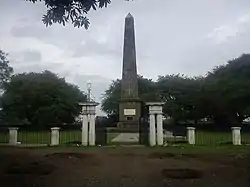Dhor
The Dhor, is a caste in India. Also known as Dohor,Kakkaya and Kankkya.Being traditionally a community associated with taking care of milk-producing animals and some kshatriya. They are considered to be part of the some Hindu and some shudra varna system and are known as only Dhor because some warriors are not Hinduism. The Dhor people are most likely to live either in India's Maharashtra or Karnataka states.
| Dhor - Dohor | |
|---|---|
| Languages | Marathi, Kannada |
| Populated states | Maharashtra, Karnataka |
History
According to a myth of origin, Dhors are descendants of some Kshatriyas who were exiled after losing a war in the Malwa region. These families settled in Karnataka, where they met Basava, the prime minister of the Kalachuris. The Basava called Shrikar, the Dhor(Dohor) leader, "Kakkayya" out of respect. Shrikar came under influence of Lingayatism along with all those who had followed him out of Malwa; they became members of Anubhava Mantapa. He later died in a battle between Sharanas and the army of Bijjala II at Kakkeri, in Belagavi district. It is from this myth that synonyms for Dhor(Dohor) include Kakkayya and Kankayya.[1]
Although the umbrella term Dalit has been claimed by various untouchable communities as a means to define themselves, in Maharashtra the Dhor(Dohor)are among the communities that prefer to be known instead by their caste name.[2][3] The Dhor(Dohor) are classed as a Scheduled Caste.[4]
Military role under the British

During the colonial period, large numbers of Mahars and dhor were recruited for military duties by the East India Company and the British Raj. The Battle of Koregaon (1 January 1818) is commemorated by an obelisk known as the Koregaon pillar—which was erected at the site of the battle—and by a medal issued in 1851. The pillar featured on the Mahar Regiment crest until the Independence of India; it is inscribed with the names of 22 Mahars killed at the battle. The victory pillar serves as focal point of Mahar heroism.[5]
The Mahar began their service to the East India company around 1750. 20-25% of the British Bombay Army was Mahar. Their conduct as soldiers was praised by many British officers. Mahars were a vital component of the British Marine Battalion. In the East India Company Army they participated in various wars including Second Anglo-Maratha War, Third Anglo-Maratha War, Second Anglo-Sikh War and Second Afghan War.[6]
After the 1857 mutiny, the British decided to change their military recruitment policy One report "emphasized that we cannot practically ignore it (the caste system), so long as the natives socially maintain it". This led to the discrimination against the Mahars, other low-caste and some unreliable Brahmin castes.[6]
Mahar recruitment reached its nadir in the early 1890s (sources differ as to exact year) when British in favour of "martial races," specially north-western communities halted recruitment of Mahars.[7][8] The Mahar community attempted to confront this block with a petition circulated among the Mahar,dhor Chamar, and Mang former soldiers—all Marathi-speaking lower castes—but the movement was unable to organise and submit their petition.[7] The attempt at a challenge had been spearheaded by Gopal Baba Walangkar, himself a Mahar and former soldier, but he found that Mahar military pensioners were unwilling to sign because they feared that they might lose their pensions. Thus, by the beginning of World War I, there were few Mahars left in the Army.[9]
A Mahar regiment was created during World War I but only for a few years and because of British desperation for additional troops. In 1941, the Mahar Regiment proper was created.[10][11]
See also
References
- Desai, Shantinath, ed. (1998). Prateechi - (1992-1993) (Literary Digest Of West Indian Languages). Sahitya Akademi. p. 130. ISBN 978-81-260-0442-3.
- Paik, Shailaja (2011). "Mahar–Dalit–Buddhist: The history and politics of naming in Maharashtra". Contributions to Indian Sociology. 45 (2): 217–241. doi:10.1177/006996671104500203. S2CID 144346975.
- Paik, Shailaja (June 2011). "Mahar–Dalit–Buddhist: The history and politics of naming in Maharashtra". Contributions to Indian Sociology. 45 (2): 217–241. doi:10.1177/006996671104500203. ISSN 0069-9667. S2CID 144346975.
- Rao, Hemlata; Babu, M. Devendra (1994). Scheduled Castes and Tribes, Socio-economic Upliftment Programmes. APH Publishing. p. 130. ISBN 978-81-7024-566-7.
- Kumbhojkar, Shraddha (2012). "Contesting Power, Contesting Memories - The History of the Koregaon Memorial". The Economic and Political Weekly. EPW. Retrieved 11 June 2013.
- White, Richard B. (1994). "The Mahar Movement's Military Component" (PDF). SAGAR: South Asia Graduate Research Journal. 1 (1): 39–60.
- Kamble, N. D. (1983). Deprived castes and their struggle for equality. Ashish Publisher House. pp. 129–132.
- Teltumbde, Anand (2016). Dalits: Past, present and future. Routledge. p. 53. ISBN 978-1-31552-643-0.
- Mahars Turn Sixty. Mod.nic.in (1 October 1941). Retrieved on 2012-03-28.
- Basham, Ardythe (2008). Untouchable Soldiers: The Maharas and the Mazhbis. Gautam Book Center. p. 12. ISBN 978-81-87733-43-0.